Urbanization and Management of the Catchment Retention in the Aspect of Operation of Storm Overflow: A Probabilistic Approach
Abstract
1. Introduction
2. Methodology
- (a)
- Determination of the logit model for the forecast of overflow discharge, which requires the separation of rainfall events in the time series of rainfall episodes, determination of changes in the characteristics of the catchment area in the period covered by the calculations, and identification of episodes of discharges by storm overflow on the basis of the measurement data;
- (b)
- Determination of rainfall characteristics in individual episodes and determination of the dynamics of rainfall changes by determining empirical distributions and adjusting theoretical distributions to them on the basis of calculations of the Kolmogorov-Smirnov test;
- (c)
- K-sampling simulations of rainfall characteristics (based on fixed theoretical distributions) in M rainfall episodes per year using the Monte Carlo Latin-HyberCube (MC + LH) method; in the case of multi-year modelling rainfall data, the number of episodes modelled in the series of rainfall shall be equal to T times the number of predicted annual series;
- (d)
- Determination of the number of storm overflow discharges for modelling K-series of rainfall using a logistic regression model;
- (e)
- The establishment of a curve describing the probability of exceeding (CDF) a specified number of discharges in a given time period;
- (f)
- Determination of the number of discharges per year (Za) and comparison with the limit value (Zm), which allows one to decide on potential change of the degree of imperviousness of the catchment area.
2.1. Logistic Regression
2.2. Separation of Rainfall Events in Time Series
2.3. Rainfall Generator
- (a)
- The mean values (μ1, μ2, …, μi)s and standard deviations (σ1, σ2, …, σi)s for the variables (xi) in j samples do not differ by more than 5% from the values obtained from the theoretical distributions;
- (b)
- Empirical distributions of modelled values of xi variables (in j samples) are in accordance with theoretical distributions; in order to check this condition, it is recommended to use the Kolmogorov-Smirnov test;
- (c)
- The value of the correlation coefficient (R) between dependent variables (xi) obtained for MC simulation data does not differ by more than 5% from the R value determined for empirical data.
2.4. Urbanization of Catchment Area in the Time Horizon
3. Object Research
4. Results
4.1. Logistic Regression
4.2. Annual Number of Overflow Dicharges and Reduction Their Number
4.3. Probabilistic Model
5. Conclusions
Author Contributions
Funding
Conflicts of Interest
References
- Sandoval, S.; Torres, A.; Pawlowsky-Reusing, E.; Riechel, M.; Caradot, N. The evaluation of rainfall influence on combined sewer overflows characteristics: The Berlin case study. Water Sci. Technol. 2013, 68, 2683–2690. [Google Scholar] [CrossRef] [PubMed]
- Brzezińska, A.; Zawilski, M.; Sakson, G. Assessment of pollutant load emission from combined sewer overflows based on the online monitoring. Environ. Monit. Assess. 2016, 188, 502. [Google Scholar] [CrossRef] [PubMed]
- EN-752. Drain. and Sewer Systems Outside Building—Part. 4: Hydraulics Design and Environmental Cosideration; British Standards Institution (BSI): London, UK, 2017. [Google Scholar]
- Llopart-Mascaro, A.; Farreny, R.; Gabarrell, X.; Rieradevall, J.; Gil, A.; Martinez, M.; Puertas, J.; Suareze, J.; del Rio, H.; Paraira, M. Storm tank against combined sewer overflow: Operation strategies to minimise discharges impact to receiving waters. Urban Water J. 2015, 12, 219–228. [Google Scholar] [CrossRef]
- Bai, T.; Mayer, A.L.; Shuster, W.D.; Tian, G. The Hydrologic Role of Urban Green Space in Mitigating Flooding (Luohe, China). Sustainability 2018, 10, 3584. [Google Scholar] [CrossRef]
- Akther, M.; He, J.; Chu, A.; Huang, J.; van Duin, B. A Review of Green Roof Applications for Managing Urban Stormwater in Different Climatic Zones. Sustainability 2018, 10, 2864. [Google Scholar] [CrossRef]
- Lund, N.S.V.; Falk, A.K.V.; Borup, M.; Madsen, H.; Mikkelsen, P.S. Model predictive control of urban drainage systems: A review and perspective towards smart real-time water management. Crit. Rev. Environ. Sci. Technol. 2018, 48, 279–339. [Google Scholar] [CrossRef]
- Kiczko, A.; Szeląg, B.; Kozioł, A.; Krukowski, M.; Kubrak, E.; Kubrak, J.; Romanowicz, J. Optimal capacity of a stormwater reservoir for flood peak reduction. J. Hydrol. Eng. 2018, 23, 04018008. [Google Scholar] [CrossRef]
- Starzec, M.; Dziopak, J.; Słyś, D.; Pochwat, K.; Kordana, S. Dimensioning of Required Volumes of Interconnected Detention Tanks Taking into Account the Direction and Speed of Rain Movement. Water 2018, 10, 1826. [Google Scholar] [CrossRef]
- Mrowiec, M. Efektywne Wymiarowanie i Dynamiczna Regulacja Kanalizacyjnych Zbiorników Retencyjnych [The Effective and Dimensioning and Dynamic Regulation Sewage Reservoirs; Wydawnictwo Politechniki Czestochowskiej: Częstochowa, Poland, 2008; ISBN 978-83-7193-424-7. (In Polish) [Google Scholar]
- Vezzaro, L.; Grum, M. A generalised dynamic overflow risk assessment (DORA) for real time control of urban drainage systems. J. Hydrol. 2014, 515, 292–303. [Google Scholar] [CrossRef]
- Dong, X.; Huang, S.; Zeng, S. Design and evaluation of control strategies in urban drainage systems in Kunming city. Front. Environ. Sci. Eng. 2017, 11, 13. [Google Scholar] [CrossRef]
- Ahmed, K.; Chung, E.-S.; Song, J.-Y.; Shahid, S. Effective Design and Planning Specification of Low Impact Development Practices Using Water Management Analysis Module (WMAM): Case of Malaysia. Water 2017, 9, 173. [Google Scholar] [CrossRef]
- Qin, H.-P.; Li, Z.-X.; Fu, G. The Effects of Low Impact Development on Urban Flooding under Different Rainfall Characteristics. J. Environ. Manag. 2003, 129, 577–585. [Google Scholar] [CrossRef] [PubMed]
- Juan, Y.-K.; Chen, Y.; Lin, J.-M. Greywater Reuse System Design and Economic Analysis for Residential Buildings in Taiwan. Water 2016, 8, 546. [Google Scholar] [CrossRef]
- Guan, M.; Sillanpää, N.; Koivusalo, H. Assessment of LID practices for restoring pre-development runoff regime in an urbanized catchment in southern Finland. Water Sci. Technol. 2015, 10, 1485–1491. [Google Scholar] [CrossRef] [PubMed]
- Itsukushima, R.; Ogahara, Y.; Iwanaga, Y.; Sato, T. Investigating the Influence of Various Stormwater Runoff Control Facilities on Runoff Control Efficiency in a Small Catchment Area. Sustainability 2018, 10, 407. [Google Scholar] [CrossRef]
- Goncalves, M.L.R.; Zischg, J.; Rau, S.; Sitzmann, M.; Rauch, W.; Kleidorfer, M. Modeling the Effects of Introducing Low Impact Development in a Tropical City: A Case Study from Joinville, Brazil. Sustainability 2018, 10, 728. [Google Scholar] [CrossRef]
- Andres-Domenech, I.; Munera, J.C.; Frances, F.; Marco, J.B. Coupling urban event-based and catchment continuous modelling for combined sewer overflow river impact assessment. Hydrol. Earth Syst. Sci. 2010, 14, 2057–2072. [Google Scholar] [CrossRef]
- Gamerith, V.; Bertrand-Krajewski, J.L.; Mourad, M.; Rauch, W. Implications of long-term stormwater quality modelling for design of combined sewer infrastructure. Urban Water J. 2011, 8, 155–166. [Google Scholar] [CrossRef]
- Barco, J.; Wong, K.M.; Stenstrom, M.K. Automatic calibration of the US EPA SWMM model for a large urban catchment. J. Hydraul. Eng. 2008, 134, 466–474. [Google Scholar] [CrossRef]
- Sun, N.; Hong, B.; Hall, M. Assessment of the SWMM model uncertainties with generalized likelihood uncertainty estimation (GLUE) framework for a high-resolution urban sewershed. Hydrol. Process. 2014, 28, 3018–3034. [Google Scholar] [CrossRef]
- Grum, M.; Aalderink, R.H. Uncertainty in return period analysis of combined sewer overflow effects using embedded Monte Carlo simulations. Water Sci. Technol. 1999, 39, 233–240. [Google Scholar] [CrossRef]
- Thorndahl, S.; Willems, P. Probabilistic modelling of overflow, surcharge and flooding in urban drainage using the first-order reliability method and parameterization of local rain series. Water Res. 2008, 42, 455–466. [Google Scholar] [CrossRef] [PubMed]
- Szeląg, B.; Kiczko, A.; Studziński, J.; Dąbek, L. Hydrodynamic and probabilistic modelling of storm overflow discharges. J. Hydroinform. 2018, 20, 1100–1110. [Google Scholar]
- Stovin, V.R.; Peng, Z. Independent Validation of the SWMM Green Roof Module. J. Hydrol. Eng. 2017, 22, 4017037. [Google Scholar]
- Wu, J.; Yang, R.; Song, J. Effectiveness of low-impact development for urban inundation risk mitigation under different scenarios: A case study in Shenzhen, China. Nat. Hazards Earth Syst. Sci. 2018, 18, 2525–2536. [Google Scholar] [CrossRef]
- Zabel, T.; Milne, I.; Mckay, G. Approaches adopted by the European Union and selected Member States for the control of urban pollution. Urban Water 2001, 3, 23–32. [Google Scholar] [CrossRef]
- ATV A-128. Richtlinie für die Bemessung und Gestaltung von Regenwasserentlastungen in Mischwasserkanälen (Standards for Dimensioning and Design Structures in Combined Sewers); Deutsche Vereinigung fur Wasserwirtschaft, Abwasser und Abfall e. V.: Hennef, Germany, 1992. [Google Scholar]
- Mantegazza, S.A.; Alessandro, G.; Mambretti, S.; Camylyn, L. Designing CSO storage tanks in Italy: A comparison between normative criteria and dynamic modelling methods. Urban Water J. 2010, 3, 211–216. [Google Scholar] [CrossRef]
- Graniero, P.A.; Price, J.S. Distribution of bog and heath in a Newfoundland blanket bog complex: Topographic limits on the hydrological processes governing blanket bog development. Hydrol. Earth Syst. Sci. 1999, 3, 223–231. [Google Scholar] [CrossRef][Green Version]
- Pradhan, B. Flood susceptible mapping and risk area delineation using logistic regression, GIS and remote sensing. J. Spat. Hydrol. 2009, 9, 1–18. [Google Scholar]
- Jato-Espino, D.; Sillanpää, N.; Andrés-Doménech, I.; Rodriguez-Hernandez, J. Flood Risk Assessment in Urban Catchments Using Multiple Regression Analysis. J. Water Resour. Plan. Manag. 2018, 144, 04017085. [Google Scholar] [CrossRef]
- Joo, J.; Lee, J.; Kim, J.H.; Jun, H.; Jo, D. Inter-Event Time Definition Setting Procedure for Urban Drainage Systems. Water 2014, 6, 45–58. [Google Scholar] [CrossRef]
- McFadden, D. Conditional logit analysis of qualitative choice behavior. In Frontiers in Econometrics; Zarembka, P., Ed.; Academic Press: New York, NY, USA, 1973; pp. 105–142. [Google Scholar]
- Restrepo-Posada, P.J.; Eagelson, P.S. Identification of independent rainstorms. J. Hydrol. 1982, 55, 303–319. [Google Scholar] [CrossRef]
- DWA-A 118. Hydraulic Dimensioning and Verification of Drain and Sewer Systems; German Association for Water, Wastewater and Waste: Hennef, Germany, 2006. [Google Scholar]
- Fu, G.; Butler, D. Copula-based frequency analysis of overflow and flooding in urban drainage systems. J. Hydrol. 2014, 510, 49–58. [Google Scholar] [CrossRef]
- Fu, G.; Kapelan, Z. Flood analysis of urban drainage systems: Probabilistic dependence structure of rainfall characteristics and fuzzy model parameters. J. Hydroinform. 2013, 3, 687–699. [Google Scholar] [CrossRef]
- Ghosh, S. Modelling bivariate rainfall distribution and generating bivariate correlated rainfall data in neighbouring meteorological subdivisions using copula. Hydrol. Process. 2010, 24, 3558–3567. [Google Scholar] [CrossRef]
- Fu, G.; Butler, D.; Khu, S.T.; Sun, S. Imprecise probabilistic evaluation of sewer flooding in urban drainage systems using random set theory. Water Resour. Res. 2011, 47, 1–13. [Google Scholar] [CrossRef]
- Vernieuwe, H.; Vandenberghe, S.; Baets, B.; Verhoest, N. A continuous rainfall model based on vine copulas. Hydrol. Earth Syst. Sci. 2015, 19, 2685–2699. [Google Scholar] [CrossRef]
- Iman, R.L.; Conover, W.J. A distribution-free approach to inducing rank correlation among input variables. Commun. Stat. Simul. Comput. 1982, 11, 311–334. [Google Scholar] [CrossRef]
- Wu, F.C.; Tsang, Y.P. Second-order Monte Carlo uncertainty/variability analysis using correlated model parameters: Application to salmonid embryo survival risk assessment. Ecol. Model. 2004, 177, 393–414. [Google Scholar] [CrossRef]
- Tarpanelli, A.; Franchini, M.; Brocca, L.; Camici, S.; Melone, F.; Moramarco, T. A simple approach for stochastic generation of spatial rainfall patterns. J. Hydrol. 2012, 472, 63–76. [Google Scholar] [CrossRef]
- Guo, Y.; Dai, J. Expanded analytical probabilistic stormwater models for use in watershed and master drainage planning. Can. J. Civil. Eng. 2009, 36, 933–943. [Google Scholar] [CrossRef]
- Dan, S.; Shamsudin, S.; Aris, A. Development of Analytical Probabilistic Model Parameters for Urban Stormwater Management. Sains Malays. 2013, 42, 325–332. [Google Scholar]
- Eckart, K.; McPhee, Z.; Bolisetti, T. Multiobjective optimization of low impact development stormwater controls. J. Hydrol. 2018, 562, 564–576. [Google Scholar] [CrossRef]
- Eckart, K.; McPhee, Z.; Bolisetti, T. Performance and implementation of low impact development—A review. Sci. Total Environ. 2017, 607, 413–432. [Google Scholar] [CrossRef] [PubMed]
- Szelag, B.; Kiczko, A.; Dabek, L. Sensitivity and uncertainty analysis of hydrodynamic model (SWMM) for storm water runoff forecasting in an urban basin-a case study. Ochr. Srodowiska 2016, 38, 15–22. (In Polish) [Google Scholar]
- Kleidofer, M.; Rauch, W. An Application of Austrian Legal Requirements for CSO. Water Sci. Technol. 2011, 64, 1081–1088. [Google Scholar] [CrossRef]
- Shafique, M.; Kim, R.; Kuong-Ho, K. Rainfall runoff mitigation by retofitted permeable pavement in an urban area. Sustainability (Besel) 2018, 10, 1231. [Google Scholar] [CrossRef]
- Choi, Y.-J.; Ahn, D.; Nguyen, T.H.; Ahn, J. Assessment of Field Compaction of Aggregate Base Materials for Permeable Pavements Based on Plate Load Test. Sustainability 2018, 10, 3817. [Google Scholar] [CrossRef]
- Leimgruber, J.; Krebs, G.; Camhy, D.; Muschalla, D. Model-Based Selection of Cost-Effective Low Impact Development Strategies to Control Water Balance. Sustainability 2019, 11, 2440. [Google Scholar] [CrossRef]
- Thorndahl, S. Stochastic long term modelling of a drainage system with estimation of return period uncertainty. Water Sci. Technol. 2009, 59, 2331–2339. [Google Scholar] [CrossRef]
- Muhaisen, O.S.; Osorio, F.; Garcia, P.A. Two-copula based simulation for detention basin design. Civil. Eng. Environ. Syst. 2009, 26, 355–366. [Google Scholar] [CrossRef]
- Hermoso, M.; García-Ruiz, M.J.; Osorio, F. Efficiency of Flood Control Measures in a Sewer System Located in the Mediterranean Basin. Water 2018, 10, 1437. [Google Scholar] [CrossRef]
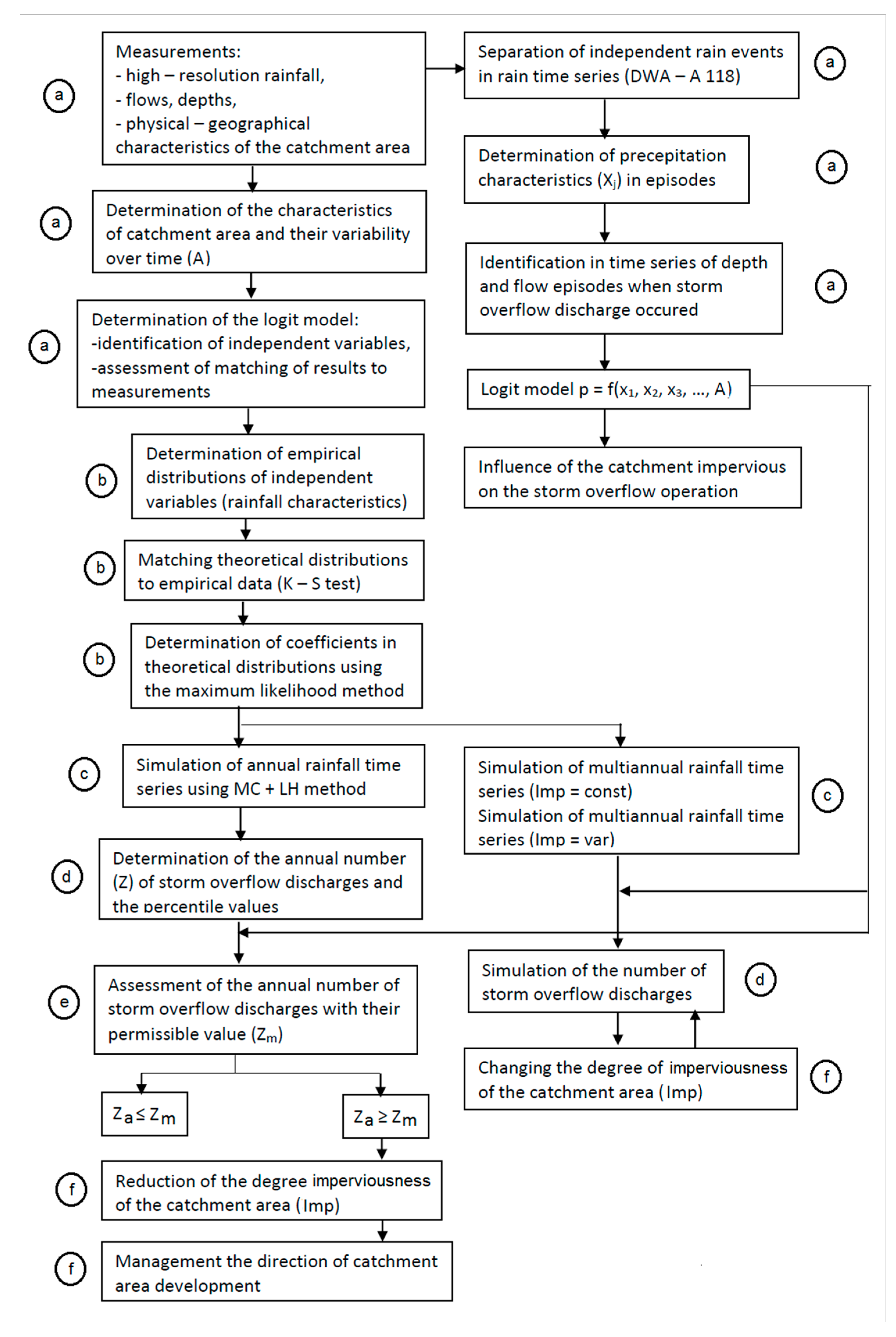

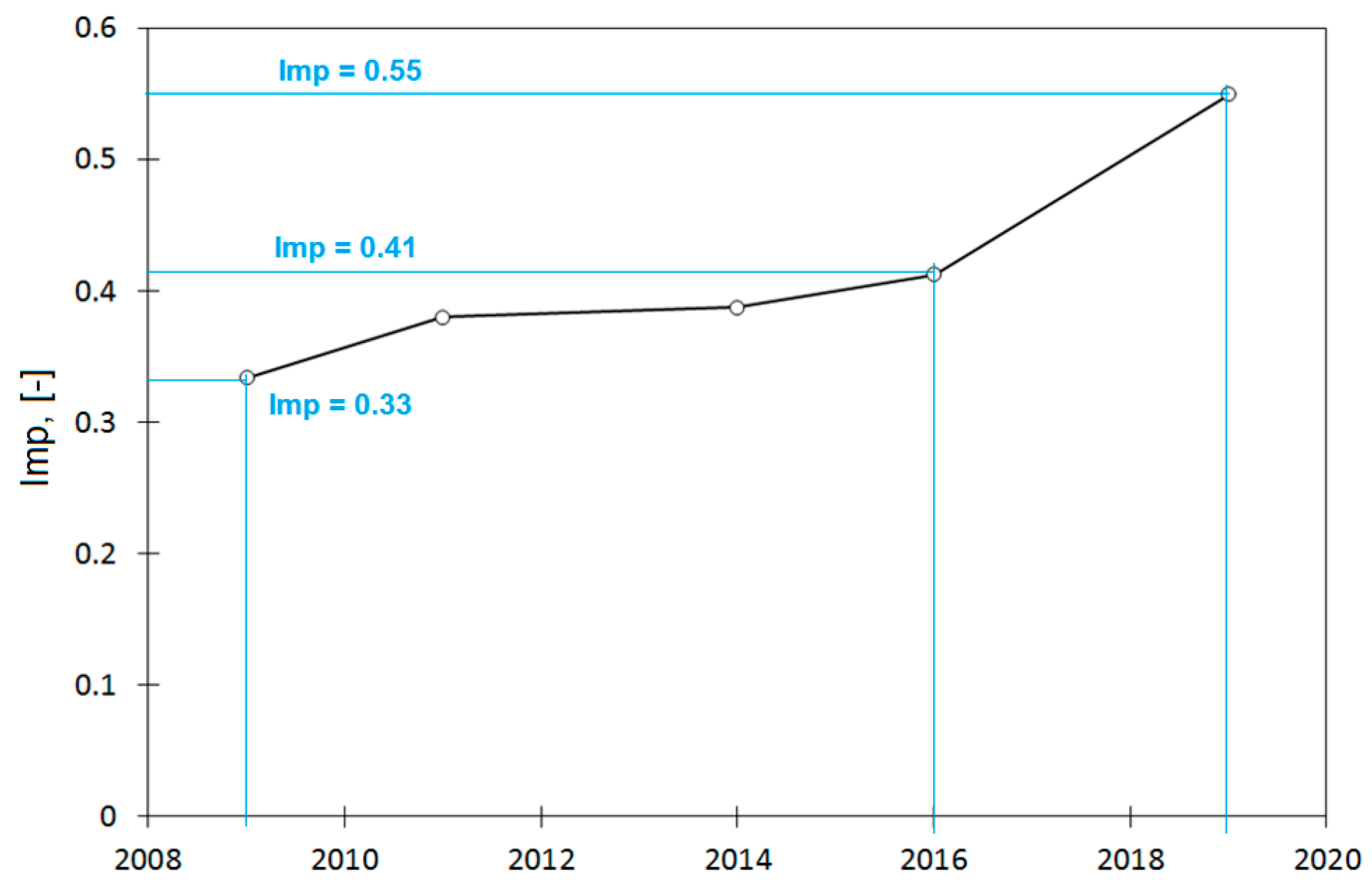
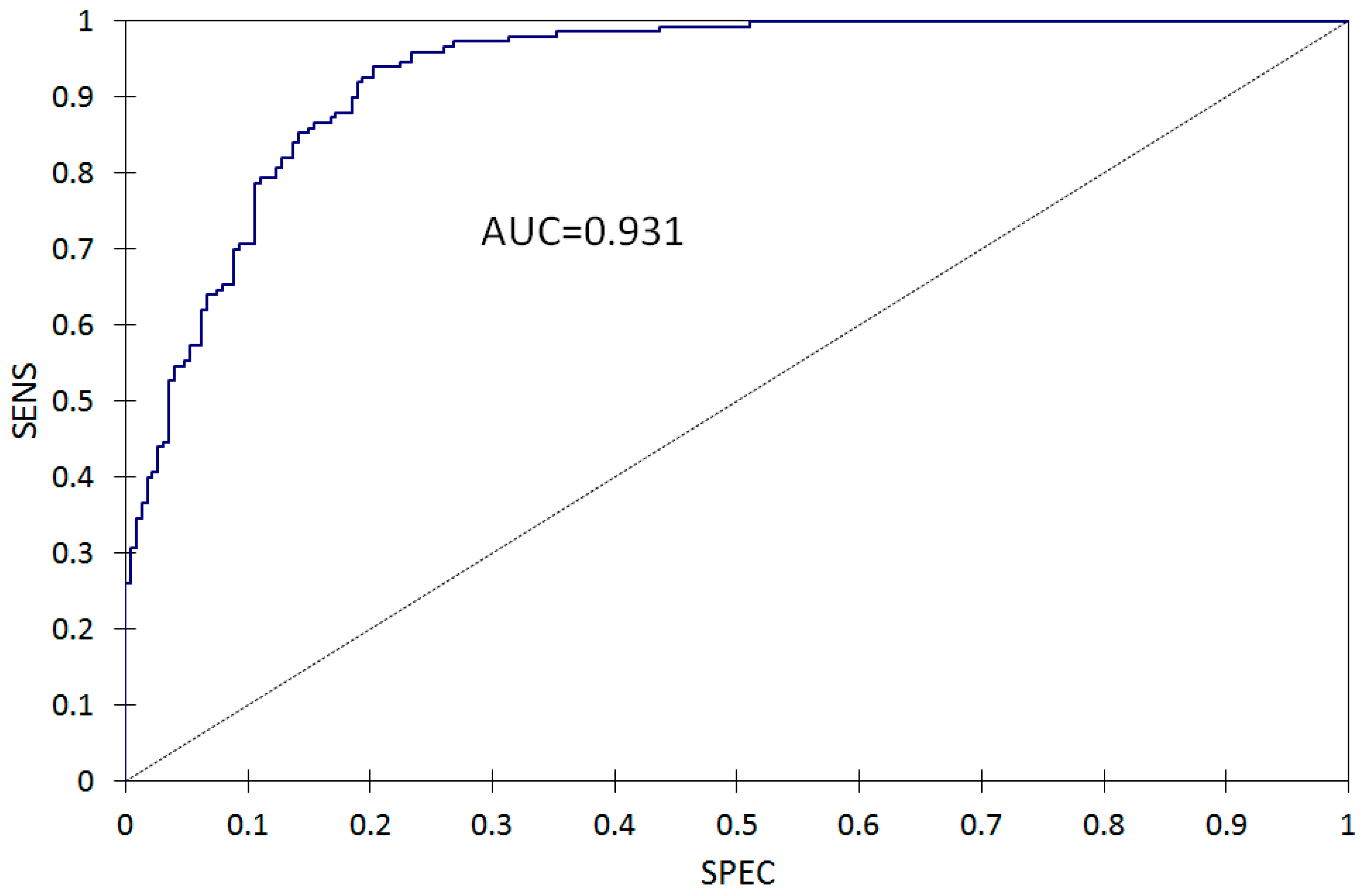
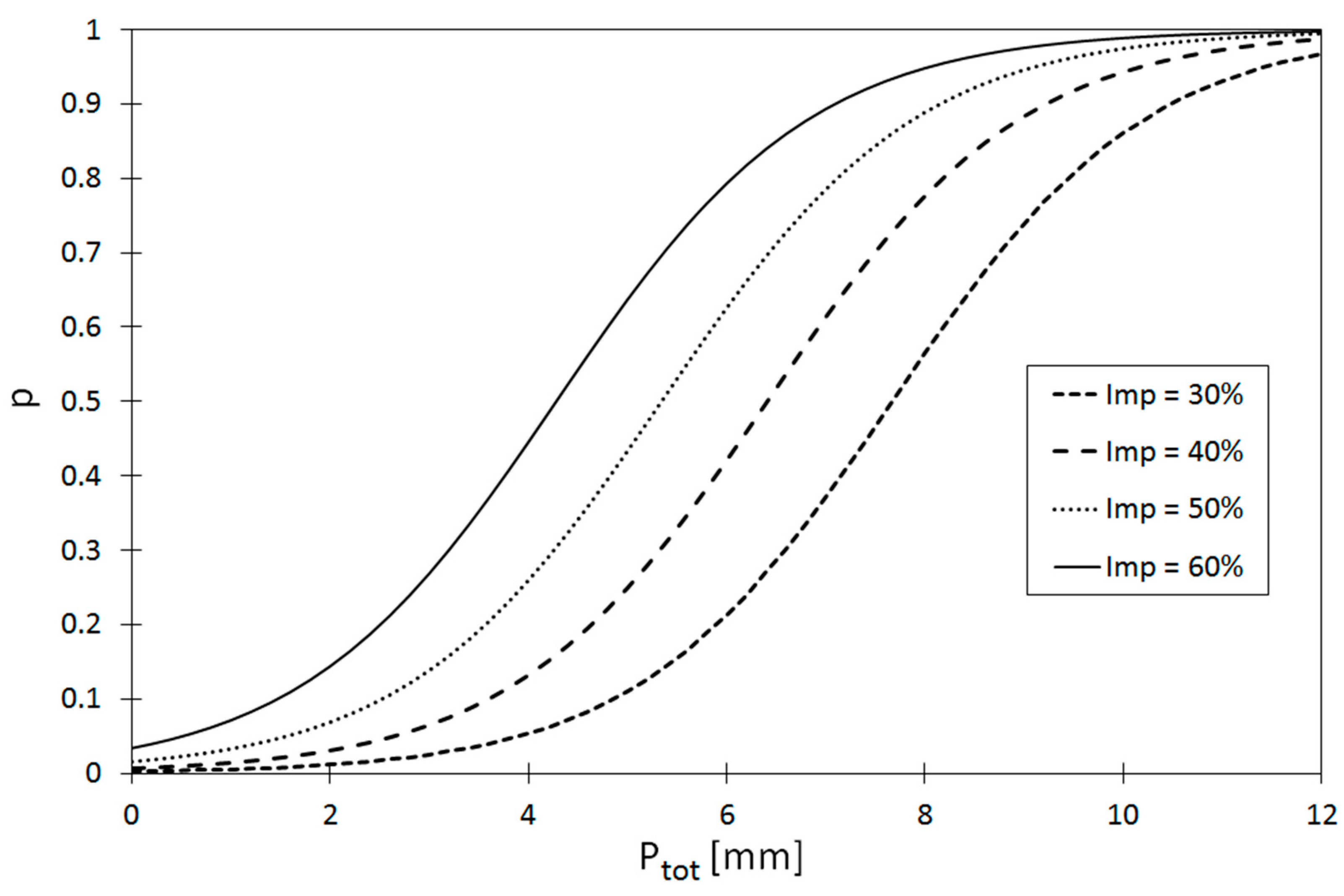


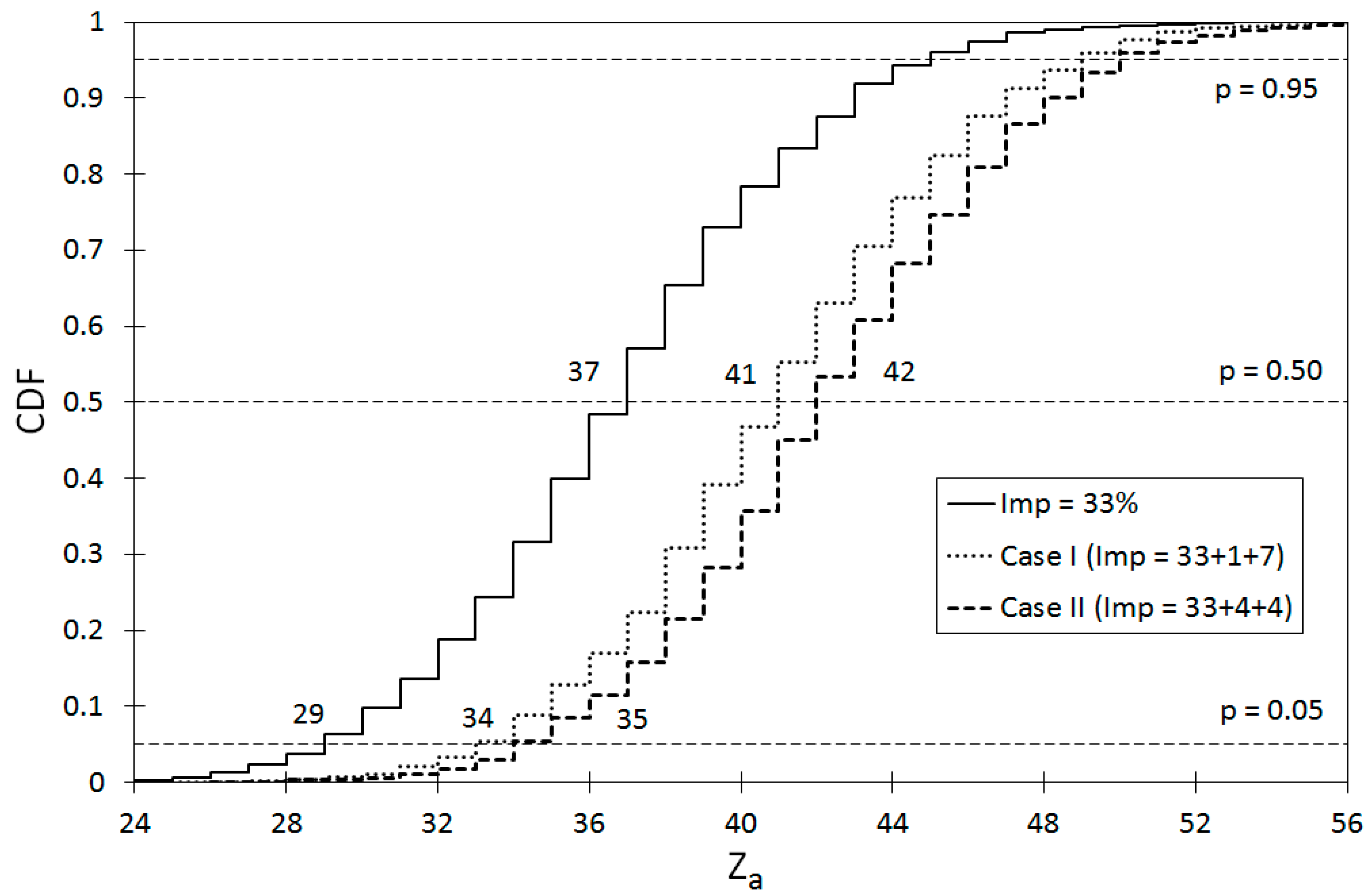
| Independent Variables | αk | Standard Deviation |
|---|---|---|
| Independent word | −6.394 | 0.887 |
| Ptot | 0.742 | 0.092 |
| tt | −0.08 | 0.01 |
| Imp | 8.322 | 1.373 |
| SENS = 88.99% | ||
| SPEC = 82.50% | ||
| Rz2 = 85.97 |
| Year | Impact | N | Zmes,a | Zlogit,a | % Imp (Control) | |
|---|---|---|---|---|---|---|
| Imp, % | Zc,logit,a | |||||
| 2008 | 33 | 43 | 15 | 13 | 33 | 13 |
| 2009 | 33 | 47 | 16 | 15 | 33 | 15 |
| 2010 | 35 | 47 | 18 | 16 | 33 | 13 |
| 2011 | 38 | 51 | 20 | 18 | 33 | 12 |
| 2012 | 38.3 | 36 | 17 | 33 | 12 | |
| 2013 | 38.6 | 41 | 18 | 33 | 14 | |
| 2014 | 39 | 44 | 24 | 33 | 18 | |
| 2015 | 40 | 58 | 24 | 21 | 33 | 13 |
| 2016 | 41.3 | 44 | 20 | 21 | 33 | 15 |
| 2017 | 45 | 38 | 20 | 19 | 35 | 12 |
| 2018 | 50 | 42 | 20 | 21 | 40 | 16 |
© 2019 by the authors. Licensee MDPI, Basel, Switzerland. This article is an open access article distributed under the terms and conditions of the Creative Commons Attribution (CC BY) license (http://creativecommons.org/licenses/by/4.0/).
Share and Cite
Szeląg, B.; Cienciała, A.; Sobura, S.; Studziński, J.; García, J.T. Urbanization and Management of the Catchment Retention in the Aspect of Operation of Storm Overflow: A Probabilistic Approach. Sustainability 2019, 11, 3651. https://doi.org/10.3390/su11133651
Szeląg B, Cienciała A, Sobura S, Studziński J, García JT. Urbanization and Management of the Catchment Retention in the Aspect of Operation of Storm Overflow: A Probabilistic Approach. Sustainability. 2019; 11(13):3651. https://doi.org/10.3390/su11133651
Chicago/Turabian StyleSzeląg, Bartosz, Agnieszka Cienciała, Szymon Sobura, Jan Studziński, and Juan T. García. 2019. "Urbanization and Management of the Catchment Retention in the Aspect of Operation of Storm Overflow: A Probabilistic Approach" Sustainability 11, no. 13: 3651. https://doi.org/10.3390/su11133651
APA StyleSzeląg, B., Cienciała, A., Sobura, S., Studziński, J., & García, J. T. (2019). Urbanization and Management of the Catchment Retention in the Aspect of Operation of Storm Overflow: A Probabilistic Approach. Sustainability, 11(13), 3651. https://doi.org/10.3390/su11133651







